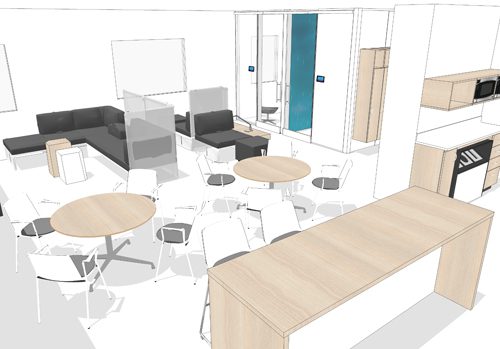

As the health care system increasingly shifts from diagnosis and treatment to prevention and wellness, clinicians and nurses are front and center to play a key role in shaping the health care environment and the patient experience. However, to manage this role effectively, their well-being must not be overlooked. According to Nurture by Steelcase’s recent report, nearly half of the clinicians cite at least one injury and/or one patient injury while on-the-job. The bulk of injuries are because of patient transfers, where one in three clinicians and nurses have experienced an injury while moving patients from bed to chair.
Recently, we visited local health leaders across the country to discuss health-care trends and the role that the physical space and design can play. Topics ranged from improving the patient experience, to the integration of technology, to clinician well-being. One continuing trend noted was that caregivers in acute care settings become so consumed with taking care of patients that they often neglect their own well-being. In fact, risk of patient injury is reported as a greater concern among clinicians and nurses than the risk of personal injury. Other attendees expressed that caregivers had inadequate spaces to work from; break rooms were either nonexistent or an afterthought; a lot of “on the fly” collaboration took place in corridors or around the welcome desk , which often resulted in stress and chaos; and most caregivers tried to focus in noisy, hectic spaces.
So what can be done to enhance the well-being of professional caregivers and in turn improve the patient experience?
The Nurture by Steelcase State of Clinicians report revealed the following findings that caregivers themselves have resorted to in an effort to find a solution:
1. Personal fitness was identified as key in successfully avoiding personal or patient injury. 65 percent of respondents say they maintain their physical fitness in order to perform tasks that are physically risky.
2. More than half of clinicians cite the use of assistive devices in patient transfers. This ranges from specialized tools like beds and recliners to makeshift solutions like using a pad or sheet as a wedge.
3. 74 percent of respondents report they regularly call on their colleagues for assistance in performing physically risky tasks.
Caregivers also highlighted that their spaces and equipment have room for improvement, and there is an appetite for this change. When asked what is the one thing they would change about their work environment, 48 percent referred to updating furniture or rethinking the design or layout of the space as most important.
There is a significant opportunity to strategically rethink how health care spaces can dramatically improve the experiences of caregivers, which in turn will create greater patient outcomes overall. We undertook 18 studies and 15,000 hours of research looking at how the physical space impacts behavior in health care settings. Intentional design of the work environment, the equipment, and how it is aligned with patient and caregiver needs was found to have a profound effect.

Another opportunity is to create an ecosystem of spaces within health care, to have spaces that are open, semiprivate and private. For instance, designated team spaces can foster more efficient and effective collaboration. On-the-move technologies and workstations can reduce bad posture and eliminate makeshift work stations that often result in medical errors. Retreat spaces for caregivers to decompress after a difficult patient situation or simply to make a private call can make a big difference to their overall focus level and well-being.
While the health care industry is ever changing, a constant is that everyone involved in health care continues to prioritize the patient experience, which is a great thing. We have waited on this acknowledgment for some time. But to improve the patient experience, every facet of the health care environment must also be looked at, including caregiver well-being.








